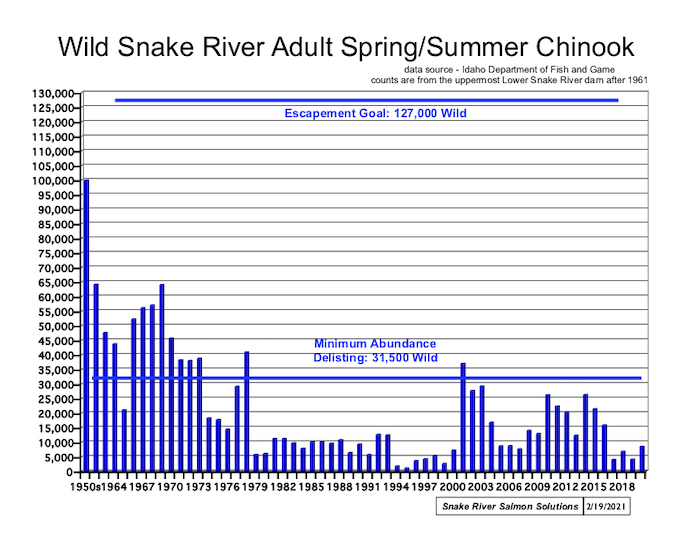forum
library
tutorial
contact

2013 Prelim Data: Spring Chinook Yearling Survival
from Above Lower Granite to Below Bonneville 52.3
by Staff
Columbia Basin Bulletin, November 1, 2013
|
the film forum library tutorial contact |

|
2013 Prelim Data: Spring Chinook Yearling Survival
by Staff
|
 Preliminary data compiled by NOAA Fisheries Service researchers indicates that Snake River yearling spring chinook salmon survival in 2013 from Lower Granite Dam's tailrace down to Bonneville Dam's tailrace was 61.9 percent, which is the third highest during the 1999-2013 timeframe, with higher survival recorded only in 2006 and 2012.
Preliminary data compiled by NOAA Fisheries Service researchers indicates that Snake River yearling spring chinook salmon survival in 2013 from Lower Granite Dam's tailrace down to Bonneville Dam's tailrace was 61.9 percent, which is the third highest during the 1999-2013 timeframe, with higher survival recorded only in 2006 and 2012.
But unusually low estimated survival of 84.5 percent from the Snake River trap near the head of Lower Granite's reservoir to the tailrace just below the dam resulted in an estimated overall survival through the hydropower system (Snake River trap to Bonneville tailrace) of 52.3 percent.
The Snake River trap-to-Lower Granite tailrace survival was the lowest estimated since 82.8 percent in 1993, the first year that data was collected, according to an Aug. 28 memo from Richard Zabel, head of the Fish Ecology Division at NOAA Fisheries' Northwest Fisheries Science Center in Seattle. The memo cautions that the data is preliminary. Final calculations could differ by as much as 3-4 percent.
The survival information was previewed by NOAA Fisheries' Paul Wagner at Wednesday's meeting of the Technical Management Team, a panel comprised of federal, state and tribal officials that mull hydro system operations that might improve fish survivals. Several upriver salmon and steelhead stocks, including Snake River spring/summer and fall chinook salmon and steelhead, are protected under the Endangered Species Act.
That lower than average above-Lower Granite survival, and in the Lower Granite Dam tailrace to Little Goose tailrace reach, "resulted in an estimated survival through the hydropower system (Snake River trap to Bonneville tailrace) of 52.3 percent," which was lower than the 2012 estimate of 58.8 percent.
Salmon steelhead swimming down from the Snake River basin in Idaho and northeast Oregon must past through eight dams on their way to the Pacific Ocean, where the survivors mature to adulthood before returning to freshwater to spawn. The uppermost dam is Lower Granite on the lower Snake River in southeast Washington; the lowermost is Bonneville on the Columbia.
"Estimated survival for yearling chinook salmon between Lower Granite and McNary dams in 2013 was 3.9 percent higher than the long-term average (78.1 percent vs. 74.2 percent). Between McNary and Bonneville Dams, estimated survival in 2013 was 8.3 percent higher than the long-term average (79.2 percent vs. 70.9 percent). Chinook survival through the hydropower system has remained relatively stable since 1999 with the exception of lower estimates in 2001 and 2004," the memo says.
"For steelhead in 2013, estimated survival through the hydropower system was 50.1 percent, which was above the long-term average of 43.2 percent but also the lowest estimate since 2008," the memo says. "Despite being 9.8 percent lower than the estimate from 2012 of 59.8 percent, the two estimates were not significantly different due to the high uncertainty of the 2012 estimate.
"Lower than average estimated mean survival from McNary Dam Tailrace to John Day Dam tailrace (79.9 percent vs. 80.7 percent average) and from Lower Monumental Dam tailrace to McNary Dam tailrace (73.9 percent vs. 75.5 percent average) contributed to an estimated survival through the hydropower system for steelhead in 2013 which was relatively low in comparison to that of recent years.
"Survival estimates for weekly release groups from Lower Granite Dam indicated that survival for steelhead decreased through the last few weeks of the season from Lower Granite Dam tailrace to McNary Dam tailrace. This pattern has been observed in previous years and could be caused by increased predation and increasing temperatures during that period," the memo says.
The estimated juvenile survival in 2013 of Snake River sockeye salmon (hatchery and wild combined) from the tailrace of Lower Granite Dam to the tailrace of Bonneville Dam was 53.6 percent, considerably higher than the mean calculated from data beginning in 1998. Estimated survival in 2013 of Columbia River sockeye salmon (hatchery and wild combined) from the tailrace of Rock Island Dam on the mid-Columbia to the tailrace of Bonneville Dam was 48.7 percent, which was slightly below the mean of 53.7 percent.
The mean flow volume at Little Goose Dam, located roughly 37 miles downstream from Lower Granite, in 2013 during the main migration period (April 1 through June 15) was 67,800 cubic feet per second, which was below the long-term (1993-2013) mean of 92.0 kcfs, and fifth lowest among mean flows over the past 21 years.
Daily flow volumes were below average for much of the season, but were above average from May 9-16 as a pulse of flow moved through, according to the memo. Mean water temperature at Little Goose Dam in 2013 during the migration period was 11.3 degrees C, which is slightly above the long-term mean of 11.1. Daily water temperatures fluctuated around the long term daily averages, with excursions above average occurring during April 4-12, May 2-16 and 3-15 June 3-15.
"In general, river conditions during the 2013 spring migration could be categorized as low flow with moderately high temperatures at times and with above average spill percentages. These conditions are similar to those occurred in 2007 and 2010," the memo says.
For more information on tracking juvenile salmon survival see CBB, Dec. 21, 2013, "World's Most Extensive Salmon Tagging Program Tracks Passage Survival At Columbia-Snake Dams"
learn more on topics covered in the film
see the video
read the script
learn the songs
discussion forum
